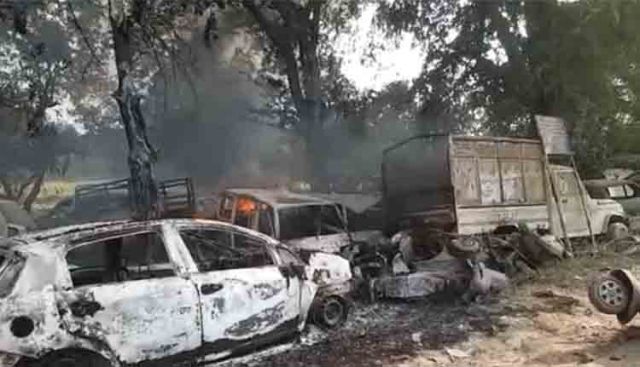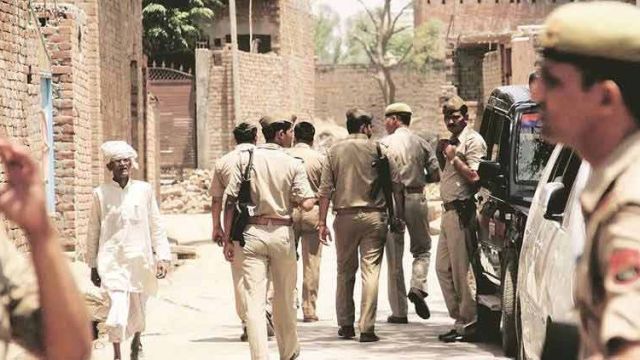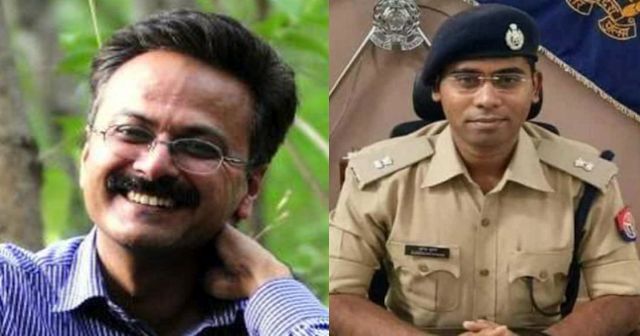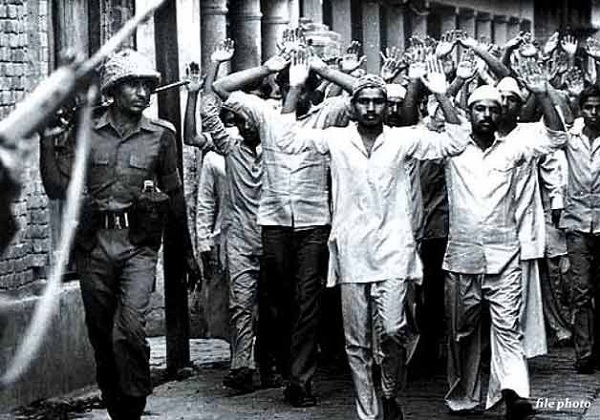
by admin | May 25, 2021 | News, Politics
 Lucknow/Bulandshahr : Four people have been arrested in connection with the killing of Inspector Subodh Kumar Singh and a young man in violence in Bulandshahr in Uttar Pradesh after cow vigilantes went on a rampage, police said on Tuesday.
Lucknow/Bulandshahr : Four people have been arrested in connection with the killing of Inspector Subodh Kumar Singh and a young man in violence in Bulandshahr in Uttar Pradesh after cow vigilantes went on a rampage, police said on Tuesday.
The police, however, maintained it would be too early to conclude about the involvement of any organisation in the violence although local officials linked the mayhem to rightwing Hindu groups.
The police said the main conspirator behind Monday’s mob violence was Yogesh Raj, who is on the run and is said to be a Bajrang Dal activist.
Additional Director General (Law and Order) Anand Kumar said those arrested were Chaman, Devendra, Ashish Chouhan and Satish, who have been named in the FIR, while the prime suspect was Yogesh Raj.
“Those arrested have been found to be leading the crowd after being identified in a video. About 40-50 others who are unidentified were involved in the incident and police is confident of identifying them with the video evidence,” he said.
The official parried questions about the political links of the three key accused who are also said to include an activist each from the BJP and the Vishwa Hindu Parishad.
“Yes, Yogesh Raj is the main conspirator,” he said, adding that he was yet to be arrested.
He said six teams have been formed to probe the incident and an SIT has been constituted to investigate the matter.
On allegations that policemen fled the spot leaving the slain Inspector alone, Kumar said the circumstances in which police personnel left the place would be analysed and till then no action would be taken against anyone.
He said the Inspector was first injured by a stone.
“He fell unconscious and was taken in a vehicle which was attacked by a mob with stones and gunfire,” he added. Videos which went viral showed the Inspector dead with a bullet wound near the vehicle and several activists running around in circles.
A .32 bore bullet was found lodged in the head of Subodh Kumar Singh.
Earlier reports said the Inspector was killed when he tried to reason with the Hindutva activists blocking a busy road with carcasses of animals they claimed were of cows.
About the death of the youth, Sumeet, only a probe can reveal whether he was killed in cross-firing or police firing, Kumar said.
He said a bullet had been recovered from the body of Sumit.
The officer said the dead officer being treated as a “martyr” and full state honour was given to him in Meerut in the presence of the police brass.
The body was taken to his village in Etah where he would be cremated with full honours.
In his village, his family broke down on seeing the mortal remains. His wife rued that he had sought leave but it was not granted. If he had been given leave, he would have been alive, she said.
His two teenage sons paid glowing tributes to their father, saying he never discriminated people on the basis of religion.
The officer’s elder son Shreya is studying MBA while his younger son Abhishek is a student of engineering.
The uncle of the dead Inspector said the family won’t accept the compensation of Rs 40 lakh announced by the government and instead wanted the presence of Chief Minister Yogi Adityanath in the village.
The government has formed a special investigation team (SIT) to probe the violence, the circumstances leading to it and to identify the people and groups involved.
Meanwhile, Bahujan Samaj Party (BSP) chief Mayawati blamed the state government for the violence in Bulandshahr, saying the “lawlessness” in the state was a result of its “faulty and wrong policies”.
In a statement, the four-time Chief Minister said that government was now faced with the same mobocracy it inculcated to make political gains over the past many years.
—IANS

by admin | May 25, 2021 | News, Politics
 Lucknow : The National Human Rights Commission (NHRC) on Thursday issued a notice to the Uttar Pradesh government over reports of a Muslim youth being killed by the state police in a ‘fake encounter’.
Lucknow : The National Human Rights Commission (NHRC) on Thursday issued a notice to the Uttar Pradesh government over reports of a Muslim youth being killed by the state police in a ‘fake encounter’.
The NHRC took suo motu cognizance of media reports which mentioned that Irshad Ahmad, 20, was killed in a ‘fake encounter’ in Muzaffarnagar.
Ahmad was shot dead in an alleged fake encounter by the Uttar Pradesh Police on Tuesday.
His father has said that Irshad had no criminal history and was killed in cold blood in a fake encounter.
The Commission has observed that the contents of the news reports, if true, raise the serious issue of the violation of human rights of the victim and his family.
Accordingly, it has issued notice to the Chief Secretary and Director General of Police, calling for a detailed report within four weeks.
—IANS

by admin | May 25, 2021 | News
 By Mohit Dubey,
By Mohit Dubey,
Lucknow : Suicides, between May and September, by two of its bright officers — one with the anti-terror squad (ATS) and the other posted as SP (East) in Kanpur — has rattled the Uttar Pradesh Police, one of the largest such forces in the country.
It also raises the question — as it does for other non-military forces around the nation — whether the men in khaki are overworked, stressed from having to meet unrealistic targets from political bosses and unable to balance their professional and personal lives.
Rajesh Sahni, a highly-decorated Indian Police Service (IPS) officer, posted as an Additional SP with the ATS, pulled the trigger on himself at his office in the upscale Gomtinagar neighbourhood of the state capital on May 29. Surendra Kumar Das, a 2014 batch IPS officer, swallowed an overdose of sulfa drugs on September 6 and died three days later. The reasons for taking the extreme step are not known yet, but colleagues say both were “stressed”, albeit for “different reasons”.
Director General of Police (DGP) O.P. Singh, who on September 8 visited the 30-year-old Das at a private hospital in Kanpur where he was battling for life, conceded that the force was in a “high level of stress”. While officers have for long been privately complaining of “heavy volume of work”, “endless work hours”, “ruined personal lives” and “demanding bosses”, the pressure on the police suddenly seems to have pushed people to the brink.
With the state government setting targets for the force so as to portray itself as a “different government which hounds out criminals”, a senior officer told IANS on condition of anonymity that “working was tougher than ever before”. The suicides were a fallout of such pressures, he added.
“The political class, past and present, fails to understand the situation on the ground and the difficulties we face… it is madly after results,” rues another SSP-level officer in eastern Uttar Pradesh. The desperation, be it personal or professional, “to get out of the rut even if it means dying” can be gauged from the fact that Das “Googled ways to die”, a colleague said.
Former DGP Vikram Singh, who served for three long years under a “tough and demanding Mayawati” also admited that high political stakes force policemen to get stressed. “The police, in any case, has been very overworked and growing crimes, shifting crime patterns and modus operandi add to our woes,” he added.
He regretted that owing to a host of issues like no holidays, lack of sleep, the sinking feeling of failure, public treatment of policemen with contempt, indifference of political bosses and almost no connect with superiors has led to an alarming fall in tolerance levels.
“We, as young officers, have worked with the likes of the legendary B.S. Bedi; they all were so connected and concerned about the well-being of their subordinate officers… sadly the joint family of police has broken,” Vikram Singh added.
Another former DGP, K.L. Gupta, said the police has become a “Draupadi” who is answerable to politicians, the public, RTI queries, courts and human rights activists.
“There certainly are forces that pull down one’s self-esteem and family discord is one reason for such steps,” he told IANS.
Brij Lal, another former DGP and currently chairman of the Uttar Pradesh SC/ST Commission, said he knows of many cases since 1981 when police officiers took the extreme step due to marital discord. He, however, added that the force was certainly overworked and needed solutions fast and quick.
Sri Ram Arun, another decorated and very respected former DGP, said that pulls and pressures in the police service “now-a-days is more than ever before”.
“There is political pressure from all sides; officers are transferred on a whim,” he maintained, adding that to sort out the mess, the policemen need to stand up against wrongs, and balance their personal and professional lives — while the political masters need to understand that “better policing can only be achieved through a better and cordial relationship with the police and its officers”.
Many serving officers IANS spoke to said they were concerned about the spate of such sad events and suggested that annual mental profiling, as is the case in police forces in many countries, and even in some para-military forces, was one way to prevent such incidents. They also felt that old-style policing and better camaraderie between the seniors and junior staff was a must as well, along with a certain improvement in working conditions.
(Mohit Dubey can be contacted at mohit.d@ians.in)
—IANS

by admin | May 25, 2021 | Opinions

Hashimpura massacre case; photo courtesy Indiatvnews.com

Mohd Asim , Senior News Editor, NDTV 24×7
On Saturday, a Delhi court acquitted 16 Uttar Pradesh police personnel accused in the 1987 Hashimpura massacre, in which more than 40 Muslims were killed in cold blood. The policemen have been set free on account of lack of evidence, and the failure of the state government to establish the identity of the accused policemen.
Here is what happened on that fateful night of May 22, 1987.
Riots had broken out in Meerut in April 1987, following the Rajiv Gandhi government’s decision to open the locks of the 17th-century Babri Masjid. After a brief lull, riots restarted in May in Meerut. Curfew was imposed and Provincial Armed Constabulary (PAC) personnel conducted searches in several Muslim localities in the city. On May 22, 1987, they booked hundreds of Muslim youth from Hashimpura, though there was no rioting in that area of Meerut city.
19 PAC personnel, under platoon commander Surinder Pal Singh, allegedly took about 50 young Muslim men, most of them daily wage labourers and poor weavers, in a van from the Hashimpura locality in Meerut to the Upper Ganga Canal in Murad Nagar, Ghaziabad, instead of taking them to the police station. They then allegedly shot some of them, one by one, and threw them into the canal. The remaining men were taken in the truck to the Hindon Canal in Makanpur on Delhi border and shot. A few of the men survived, pretending to be dead and later filed FIRs against the policemen.
The court judgement acquitting all the accused has come a good 28 years after the incident. And now, we are made to believe that no one actually killed those over 40 innocent Muslims. A typical case of justice not just delayed, but also denied.
So why is Hashimpura important? In 1987, I was a six-year-old kid. So I don’t remember hearing or reading about the carnage. But growing up in Aligarh also meant living through many subsequent riots, especially in the early 90s. Hashimpura came up in household discussions every time there was a communal skirmish in the town. It was the first-of-its-kind case of custodial killing. It became synonymous with the PAC – the dubious, notorious and blatantly communal Provincial Armed Constabulary of the UP Police.
Vibhuti Narain Rai, who was the Superintendent of Police, Ghaziabad when the massacre took place, said in his book ‘Combating Communal Conflicts–Perception of Police Neutrality During Hindu-Muslim Riots in India’ that most of the police personnel posted in Meerut saw the riots as a result of Muslim “mischief”, while ignoring or overlooking the role of Hindutva groups in fanning them. They claimed that Meerut had become a “mini-Pakistan” because of “Muslim intransigence” and that it was necessary to teach the community a lesson.
Mr Rai, who is also writing a Hindi book on the massacre, titled ‘Hashimpura May 22′, has posted some translated excerpts of it on his blog: http://vibhutinarain.blogspot.in/
Here is a chilling account from his book of the police barbarity that unfolded on that dirt track by the canal.
“Every survivor who hit the ground after being shot at tried hard to pretend he is dead and most hanged on the canal’s embankments with their heads in water and the body clutched by weeds to show to their killers that they were dead and no more gunshots fired at them. Even after the PAC personnel had left, they lay still between water, blood and slush. They were too scared and numbed even to help those who were still alive or half dead. So much so that even after their tormentors had gone, they considered every person coming there as a member of that gang. Leave alone seeking help, they would further squeeze their bodies into themselves – this especially if the person was in Khaki.”
Politically, too the killings reverberated loud. The Congress that was in power in UP has never won Meerut since then and also could not make it back to the power in the state. Mufti Mohd Sayeed, who today shares power with the BJP in Jammu and Kashmir, resigned from the Rajiv Gandhi cabinet after the incident.
But somehow, Hashimpura didn’t become as big a political and media issue as would be natural for a massacre of this kind. Was it because it happened under the Congress’ watch, and so it was easy to paint it as only a case of police excess? How can a gang of policemen dare to execute a killing as stunning as that without orders from top — and I include both their administrative as well as political bosses?
Successive state governments headed by SP and BSP never showed any interest in taking the case to its logical end. This was evident in the case being transferred to Delhi in 2002 on the orders of the Supreme Court.
Even if we were to believe that these 16 men were not responsible for the killings, we as a country need to know who were. Even if it is 28 years later. A democracy that is run by the rule of law and Constitution cannot let such a heinous crime go unpunished.
Saturday’s order that set the killers of Hashimpura free is a stark commentary on how the institutions of state conspire to deny justice to its citizens. May be in this case there was no “collective conscience to satisfy”.
Courtesy : NDTV.COM

 Lucknow/Bulandshahr : Four people have been arrested in connection with the killing of Inspector Subodh Kumar Singh and a young man in violence in Bulandshahr in Uttar Pradesh after cow vigilantes went on a rampage, police said on Tuesday.
Lucknow/Bulandshahr : Four people have been arrested in connection with the killing of Inspector Subodh Kumar Singh and a young man in violence in Bulandshahr in Uttar Pradesh after cow vigilantes went on a rampage, police said on Tuesday.



